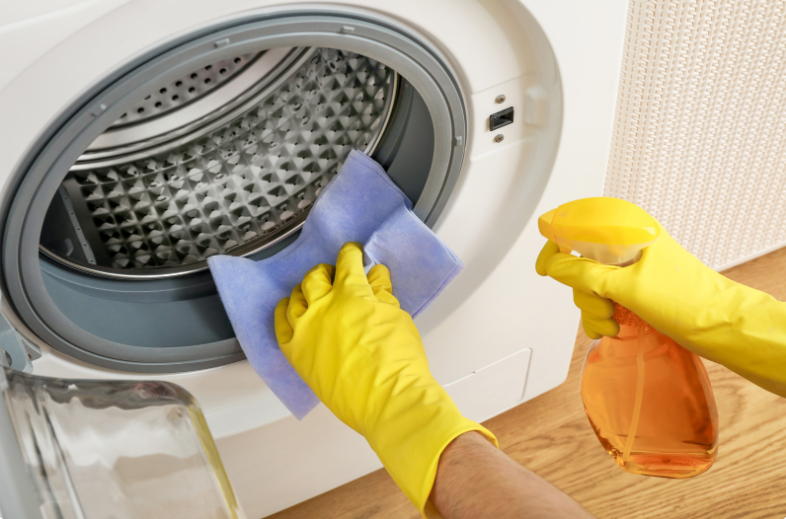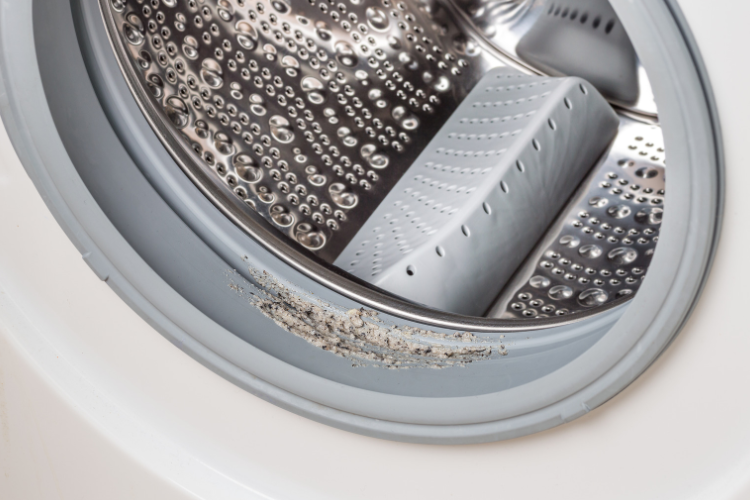- Why Does Mold Develop on Washing Machine Seals?
- What Are the Signs of Mold in Your Washing Machine?
- What Causes a Washing Machine Door Seal to Go Black?
- How to Prepare for Cleaning the Washing Machine Seal?
- How to Clean Washing Machine Seal?
- How to Perform a Maintenance Wash?
- What Are Alternative Methods for Removing Stubborn Mold?
- How to Prevent Mold Growth on Washing Machine Seals?
- What Is the Grey Sludge in My Washing Machine Seal?
- Conclusion
- FAQs on How to Clean Washing Machine Seal
Keeping your washing machine fresh and efficient means paying attention to one often-overlooked part — the rubber seal.
In this guide, I’ll show you how to clean washing machine seal and tackle that nasty mold buildup that can make your laundry smell musty.
Let’s dive into the exact steps I take to keep my washer clean, hygienic, and in top condition.
Why Does Mold Develop on Washing Machine Seals?
If you’ve noticed black spots or unpleasant smells around the door of your washing machine, the rubber seal is probably harbouring mould.
Front-loading machines are especially prone to this problem. The seal traps moisture, detergent residue, and even fabric softener — the perfect breeding ground for mildew and mould.
What Are the Signs of Mold in Your Washing Machine?
Wondering whether your washing machine seal needs attention? Here are the red flags I usually spot:
- A musty or damp smell inside the drum
- Visible black or grey mould spots on the rubber gasket
- Clothes smelling funky after a wash
- Slimy or sticky texture when touching the seal
If any of these sound familiar, it’s time to give that seal a thorough clean.
What Causes a Washing Machine Door Seal to Go Black?
Black discolouration is often caused by:
- Mould and mildew growth
- Soap scum and detergent residue
- Hard water mineral deposits
- Lack of air circulation
Over time, these things turn your door seal black and slimy. Regular cleaning prevents this.
How to Prepare for Cleaning the Washing Machine Seal?
Before I start, I always gather the right tools and ingredients. Here’s my go-to list:
- White vinegar or a commercial mildew remover
- Baking soda
- Microfibre cloths
- Soft-bristled brush (an old toothbrush works too)
- Rubber gloves
- Warm water
I also make sure the washing machine is empty and unplugged for safety.
How to Clean Washing Machine Seal?
Step 1: Wipe Away Loose Dirt
I begin by pulling back the rubber seal gently and wiping away any lint, hair, or trapped detergent using a damp cloth.
Step 2: Apply a Cleaning Solution
Next, I mix equal parts white vinegar and warm water. This natural solution works wonders for breaking down grime and killing mould spores. I soak a cloth in the mix and press it against mouldy areas.
Alternatively, for tougher mould, I use a washing machine-safe mildew remover spray.
Step 3: Scrub the Seal
With an old toothbrush or a soft brush, I scrub all the folds and crevices of the seal. It’s where most of the mould hides, so I take my time to get into every corner.
Step 4: Rinse and Dry
After scrubbing, I use a clean cloth to rinse the area with fresh water, then wipe everything dry. This is crucial — moisture is what started the problem in the first place.
How to Perform a Maintenance Wash?
Once I’ve cleaned the seal, I like to give the whole machine a deep refresh.
| Step | What I Use | Purpose |
| Add to Drum of the Machine | 2 tablespoons baking soda | Neutralises smells |
| Add to Drawer of the Machine | 2 cups white vinegar | Breaks down residue |
| Set Cycle | Hottest & longest cycle | Cleans the internal system |
Running this cycle clears out any lingering mould, detergent build-up, or odours.
What Are Alternative Methods for Removing Stubborn Mold?
Sometimes, regular cleaning isn’t enough. Here are a few other things I’ve tried:
How To Use Bleach To Clean Washing Machine Seal?
If natural cleaners don’t cut it, I mix one part bleach with four parts water, apply it carefully with a cloth, and rinse thoroughly.
It’s effective, but I avoid using bleach too often as it can degrade the rubber.
How To Use Baking Soda Paste To Clean Washing Machine Seal?
I make a thick paste of baking soda and water, apply it directly to mouldy areas, leave it for 10–15 minutes, then scrub and rinse.
It’s great for spot treatment.
How to Prevent Mold Growth on Washing Machine Seals?
Prevention is much easier than constant cleaning. Here’s what I do after every wash:
- Wipe the seal dry after each cycle
- Leave the door ajar to let the drum air out
- Use the right amount of detergent — too much creates excess suds and residue
- Clean the seal monthly as part of my appliance care routine
What Is the Grey Sludge in My Washing Machine Seal?
That grey sludge is usually a combination of:
- Detergent build-up
- Fabric softener residue
- Skin oils and dirt from clothes
- Mould and bacteria
It collects in the folds of the seal. I clean it out monthly to avoid bad smells and keep the machine hygienic.
Conclusion
Now that you know how to clean washing machine seal, you can say goodbye to mouldy smells and hello to fresh laundry.
A little effort goes a long way. Regular maintenance keeps your washer running smoothly and your clothes smelling clean.
So, next time you notice that rubber seal looking a bit grimy, follow this guide — your washing machine (and wardrobe) will thank you!
FAQs on How to Clean Washing Machine Seal
1. How often should I clean my washing machine seal?
I clean mine once a month. If you wash heavily soiled clothes or notice smells, you might want to do it more often.
2. Can I use bleach to clean the rubber seal?
Yes, but sparingly. Always dilute it and rinse thoroughly to protect the rubber.
3. What causes black mould on the seal?
Moisture, leftover detergent, and lack of ventilation cause black mould to form inside the seal folds.
4. Is vinegar safe for cleaning washing machine seals?
Absolutely. I use it all the time — it’s a natural mould killer and deodoriser.
5. Why does my machine still smell after cleaning the seal?
The issue may be deeper in the drum or drain. Try a maintenance wash and clean the detergent drawer too.




0 Comments